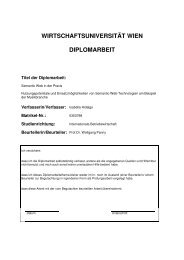Wirtschaftsuniversität Wien Magisterarbeit - SemanticLab
Wirtschaftsuniversität Wien Magisterarbeit - SemanticLab
Wirtschaftsuniversität Wien Magisterarbeit - SemanticLab
You also want an ePaper? Increase the reach of your titles
YUMPU automatically turns print PDFs into web optimized ePapers that Google loves.
matches the users preferences before it actually loads and can set cookies on the users<br />
computer.<br />
Although all those features are clearly important, it has to be mentioned that the aim<br />
of this thesis was not to develop a P3P compliant Firefox extension but to provide a basic<br />
but user-friendly P3P client which can then be further enhanced by the community.<br />
Furthermore, developing a fully P3P compliant client requires, in the view of the<br />
author, at least several man-months to be fully accomplished. In addition to that, it<br />
has to be questioned if all requirements of P3P can actually be implemented using a<br />
Firefox extension or if a separate plugin would be necessary. So although Webprivacy<br />
does not fulfill all P3P requirements, it is still a useful, basic P3P client by providing<br />
some user-friendly features which will be described next.<br />
6.3.2. Functionality<br />
An important element in designing Webprivacy was to make it as user-friendly as possible.<br />
This was accomplished by an easy to use preference system and a toolbar which<br />
clearly indicates the current P3P status. With Webprivacy, users can now easily define<br />
their own level of privacy by using the “Options” dialog of Firefox. The preferences<br />
which can be set are grouped into four thematically clustered areas (Health & Medical,<br />
Financial & Purchase, Personally identifiable and Non-Personally identifiable) according<br />
to the definition of P3P. The descriptions from each property were taken directly from<br />
the P3P standard (cp. [W3Ca, Chapter 6]) and are similar to Privacy Bird, a plugin<br />
for Microsoft’s Internet Explorer which was described earlier. In addition to that, users<br />
have the option to use pre-defined levels of privacy (low, medium and high) or define a<br />
custom level as shown in Figure 6.3.<br />
If a website does not match the users’ privacy preferences and the appropriate status<br />
is shown in the toolbar, users of course want to know why the website is violating their<br />
privacy preferences. So the original XML-parser from Privacyfox was enhanced by a<br />
component which actually checks the P3P policy against the users’ preferences in the<br />
first step and, if they do not match, provides a list of reasons why they do not match as<br />
shown in Figure 6.4.<br />
62





